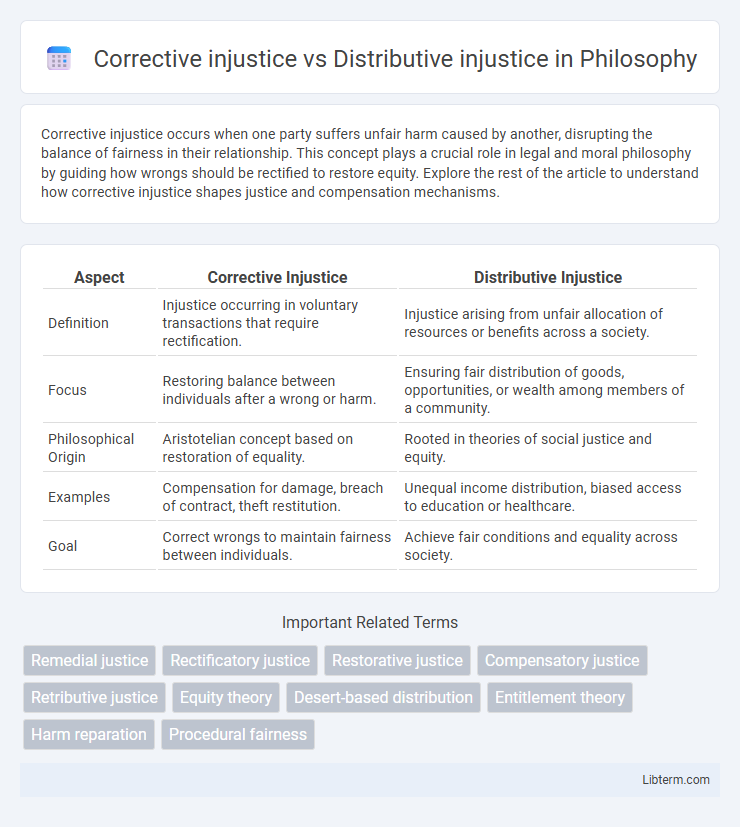Corrective injustice occurs when one party suffers unfair harm caused by another, disrupting the balance of fairness in their relationship. This concept plays a crucial role in legal and moral philosophy by guiding how wrongs should be rectified to restore equity. Explore the rest of the article to understand how corrective injustice shapes justice and compensation mechanisms.
Table of Comparison
| Aspect | Corrective Injustice | Distributive Injustice |
|---|---|---|
| Definition | Injustice occurring in voluntary transactions that require rectification. | Injustice arising from unfair allocation of resources or benefits across a society. |
| Focus | Restoring balance between individuals after a wrong or harm. | Ensuring fair distribution of goods, opportunities, or wealth among members of a community. |
| Philosophical Origin | Aristotelian concept based on restoration of equality. | Rooted in theories of social justice and equity. |
| Examples | Compensation for damage, breach of contract, theft restitution. | Unequal income distribution, biased access to education or healthcare. |
| Goal | Correct wrongs to maintain fairness between individuals. | Achieve fair conditions and equality across society. |
Introduction to Corrective and Distributive Injustice
Corrective injustice addresses individual wrongs through rectification, ensuring fairness by restoring parties to their original positions after a wrongful act, such as theft or breach of contract. Distributive injustice concerns the unfair allocation of resources or opportunities within a society, highlighting systemic inequalities in wealth, power, or rights. Understanding these concepts is essential for analyzing legal and ethical frameworks that govern justice in personal and social contexts.
Defining Corrective Injustice
Corrective injustice occurs when an individual's rights or entitlements are violated, necessitating a remedy that restores the original balance between parties involved, often in the context of private disputes such as theft or breach of contract. Distributive injustice, by contrast, involves unfair allocation of resources or opportunities across a society, affecting broader social equity and collective welfare. Corrective injustice specifically addresses the rectification of wrongful gains or losses to ensure fairness in individual exchanges or transactions.
Understanding Distributive Injustice
Distributive injustice occurs when resources, opportunities, or wealth are allocated unfairly across members of a society, leading to inequality and social tension. Unlike corrective injustice, which addresses the rectification of wrongful losses or harms between individuals, distributive injustice centers on systemic structures that create persistent disparities. Understanding distributive injustice requires examining economic policies, social norms, and institutional practices that perpetuate unequal distribution and hinder social equity.
Historical Perspectives on Justice Theories
Corrective injustice, rooted in Aristotle's theory of justice, focuses on rectifying wrongs between individuals by restoring fairness through compensation or punishment. Distributive injustice concerns the unequal allocation of resources or opportunities within a society, emphasizing fairness in social and economic distributions, as seen in John Rawls' principles. Historically, justice theories evolved from emphasizing individual rectification to addressing systemic inequalities, reflecting shifts in philosophical and political thought on fairness and equity.
Key Differences Between Corrective and Distributive Injustice
Corrective injustice involves rectifying wrongs between individuals, typically addressing unfair harm or losses through compensation or reparation, whereas distributive injustice pertains to the unfair allocation of resources, wealth, or opportunities across a society. Corrective justice emphasizes restoring equality by correcting specific transactions or actions, while distributive justice focuses on the overall fairness of social and economic arrangements. The key difference lies in corrective justice targeting individual disputes requiring redress, contrasted with distributive justice addressing systemic equity and resource distribution.
Philosophical Foundations of Justice
Corrective injustice addresses wrongs in voluntary transactions by restoring balance between parties, grounded in Aristotle's concept of justice as rectification of harm. Distributive injustice concerns the unfair allocation of resources or benefits within a community, reflecting principles of equity and proportionality in social justice theory. Philosophically, corrective justice emphasizes individual rights and restitution, while distributive justice centers on systemic fairness and the common good.
Legal Implications of Corrective Versus Distributive Injustice
Corrective injustice addresses violations where one party wrongfully harms another, necessitating legal remedies to restore the injured party to their original position through compensation or restitution. Distributive injustice involves unfair allocation of resources or benefits, prompting legal frameworks to establish equitable policies and regulations that ensure fair distribution in society. Legal implications of corrective injustice focus on restoring balance between individuals, while distributive injustice emphasizes systemic fairness and social justice through law.
Examples of Corrective Injustice in Society
Corrective injustice occurs when an individual suffers harm due to wrongful actions such as fraud, theft, or breach of contract, requiring restitution to restore fairness. For example, if a landlord unlawfully withholds a tenant's security deposit, this creates corrective injustice addressed through compensation or legal remedies. Unlike distributive injustice, which concerns the unfair allocation of resources, corrective injustice focuses on righting specific wrongs between parties to repair imbalances caused by wrongful conduct.
Real-World Cases of Distributive Injustice
Distributive injustice refers to the unfair allocation of resources, opportunities, or wealth among members of a society, often resulting in systemic disadvantages for marginalized groups, as seen in cases like racial wage gaps and unequal access to education. Corrective injustice, by contrast, addresses the rectification of wrongs caused by one party to another, such as in tort claims or contract breaches. Real-world cases of distributive injustice include the Flint water crisis, where inequitable resource distribution led to public health disparities, and global vaccine distribution challenges that highlight disparities between wealthy and low-income countries.
Addressing Injustice: Practical Solutions and Policy Recommendations
Corrective injustice involves rectifying wrongs between individuals through compensation or restitution, emphasizing fairness in restoring prior conditions. Distributive injustice pertains to the unequal allocation of resources and opportunities, requiring policies that promote equity and social welfare to ensure fair distribution. Practical solutions for addressing both types include targeted legal frameworks for corrective justice and inclusive social policies, such as progressive taxation and affirmative action, to mitigate systemic disparities.
Corrective injustice Infographic

 libterm.com
libterm.com